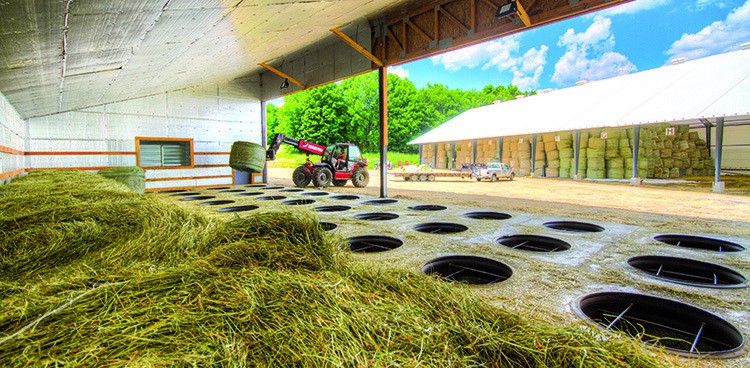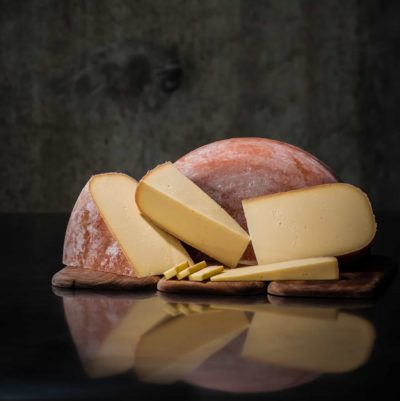
In a perfect world, meadows would be green, days would be sunny, and cows would always have something fresh to eat. But life is tough. It rains, it snows, and in much of the United States, fields lie dormant in winter. The challenge of the dairy farmer has long been a challenge of weather: how to harvest hay when it’s just abundant enough, nutritious enough, and dry enough not to transform into a pile of moldy, unappetizing mush.
In the late 19th century, farmers welcomed a new trend that promised to help. Though touted as modern, the system—called “ensiling”—was based on an ancient practice: fermentation. Here’s how it works: High-moisture hay or grain is placed in an oxygen-free environment. Over several weeks, naturally present lactic acid bacteria consume sugars, creating enough acidity to preserve the forage for years if unopened. Think of it as a kind of sauerkraut made from hay—nutritious, delicious, and probiotic. It caught on—in rainy regions of Europe and the US (like New England), fermented feed, or “silage,” is now the norm for dairy cows.
But on an unassuming back road in rural Craftsbury, Vt., something very different is happening. Dave Thomas, manager of the Randi Albert Calderwood Cropping Center, flips a switch. A humming noise begins, which quickly turns into a roar—like a spaceship about to launch. He’s just fired up a super-powerful furnace that propels 104-degree air into an adjacent room with 50 moist hay bales. The hot air circulates in and out over several hours until the bales’ moisture level drops substantially—from as much as 60 to under 12 percent. When Jasper Hill Farm built this contraption in 2015, it was the most modern hay drying facility in the US—a staggering feat for an artisanal cheesemaker. So what motivated the massive investment, given that silage is such a nutritious and convenient option?
When made with milk from silage-fed cows, certain cheese varieties are susceptible to damage from mischievous microbes.
Take Alpine styles, like Jasper Hill’s Alpha Tolman: Normally the wheels are tawny and smooth, with a dense, evenly textured paste. But picture them punctuated with horizontal cracks—“like somebody blew bubbles inside them,” says sales and marketing manager Zoe Brickley. That defect is caused by bacteria in the Clostridium genus. Found naturally in the soil, the microbes get swept up in hay during harvesting. Anaerobic silage provides an environment in which they thrive, and their spores can travel into cows’ milk. In firm, aged cheeses like Alpha Tolman, the bacteria begin noshing happily on carbohydrates, metabolizing them into rancid-tasting butyric acid and inflating carbon dioxide.
That “late blowing” defect is one reason that name-protection regulations for many European cheeses—including Parmigiano Reggiano—prohibit the use of fermented feed. To satisfy the demand for dry feed among Reggiano producers, German company AgriCompact Technologies has been building hay dryers in the Emilia Romagna region of Italy for decades—but the Jasper Hill facility was the first the company built in the United States. According to Sabine Zastrow, AgriCompact’s managing director, dryers make the most sense “where there’s a real challenge in weather conditions.” By protecting the forage not just from rain, but also from the bleaching power of the sun, “we are able to preserve the color and aroma of the hay,” she says. For that reason, “where there are cheesemakers, there should be hay dryers.”
It’s not just Alpha Tolman that matters to Jasper Hill. The farm is using milk from its dry hay–fed cows to make all its unpasteurized cheeses, from Bayley Hazen Blue to Winnimere, and for good reason: Listeria monocytogenes. This bacterial culprit, also found in soil, usually can’t survive in highly acidic, anaerobic environments—but if a little bit of oxygen is present, it does just fine. In silage, accidental holes in plastic wrapping or poor compacting of hay bales can increase the likelihood of slow but steady listeria contamination. No cheesemaker wants this pathogen getting into their milk, as it can cause sickness and even death in humans.
Many makers deal with this type of pathogenic threat by pasteurizing milk—a quick way to eliminate “bad” microbes—but the process also wipes out the complex ecosystem of microflora unique to the milk. Instead, Jasper Hill has adopted a more comprehensive strategy: preventing unwanted microbes from entering the milk in the first place.
After teaming up with microbiologists, the farm began screening the microbial content of its milk in 2011—not only the sheer bacterial count, as many makers do, but the actual proportions of beneficial, spoilage, and pathogenic bacteria. “You could have less than 1,000 total bacteria (in your milk),” says Jasper Hill co-owner Mateo Kehler, “but if 900 of them are listeria, well, that’s not good.” Years of study—plus building an on-site lab in 2014—have allowed the team to link shifts in microbial populations to different practices at the farmstead. One conclusion? Dry feed, Kehler says, has helped the farm eliminate listeria completely from its milk supply.
“The microbial ecology of raw milk is the sum of the practices on a farm,” says Kehler. “How you feed animals, how they’re bedded, the milking protocols, how you clean your equipment…the actual design.” And so that massive dryer set in Vermont’s backwoods is just one small part of a broader philosophy, he says: “Our commitment to raw-milk cheese and the practices required to produce delicious, safe product.”
Featured Image: Bob Montgomery Images/Jasper Hill Farm




